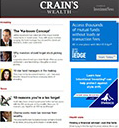While it might be fun, and even entertaining, to banter about when the Federal Reserve will finally raise interest rates, the fretting over the market's reaction to higher rates is often futile and overwrought.
That was the general consensus of a panel of six investment experts brought together by Crain's Wealth's sister publication InvestmentNews in Chicago to shed some light on what lies ahead in the markets for the rest of 2015.
“It isn't as important to us exactly when the Fed raises rates as it is that the Fed will raise rates, and that's something the market is already starting to price in,” said Michelle Picard, portfolio manager and managing principal at Geneva Capital Management.
Advertisement
Ms. Picard has been among the few outliers among Fed watchers who believed a 2015 rate hike would be later in the year than June; she is now adjusting her September rate-hike prediction to “sometime before the end of the year.”
The conversation among panelists at the round table quickly skipped past the question of whether the Fed should be raising rates to the repercussions of such a move on the markets — most thinking it will be tolerable.
Regarding the threat of another “taper tantrum” like the spike in bond yields in May 2013 on news the Fed might dial back quantitative easing, David Kelly, chief global strategist at J.P Morgan Asset Management, said: “Such is life.”
Drawing an analogy to an adult's reaction to a child's temper tantrum, Mr. Kelly said: “The Fed needs to not worry too much about another taper tantrum. The correct policy is to ignore the tantrum.”
Assuming the panel is on point, the issue for investors becomes how to adjust a portfolio accordingly.
Hugh Lamle, president of M.D. Sass, likes to think of a rate hike as a kind of tax break for investors dependent on bond yields for income.
“These low rates have essentially been a tax on middle-class households because they've seen their incomes shrink,” he said.
SIGN OF STRENGTH
In terms of investment opportunities in a rising-rate cycle, Jonathan Brodsky, managing director at Advisory Research Investment Management, stressed that a tightening move should be interpreted as what he believes it really is: a sign of the strength of the U.S. economy.
Mr. Kelly reiterated the point, saying, “If rates are going up because of an improving economy, the natural reaction to seeing those resulting losses in bond portfolios is seeing money move to equities.”
Time will tell whether a rate hike does lead more investors toward equities as the bond market adjusts to a scenario not seen in nearly a decade. But Mr. Kelly added that bond bear markets are never as scary and severe as equity bear markets.
That is a particularly important point for all those investors who haven't known anything but falling interest rates, a point made by Ron Dugan, vice president and investment officer at Guidestone Funds.
“Investors should be expecting rates to rise because that's all we've been talking about for years now,” he said. “I think people should expect one rate hike by the end of the year.”
The panelists agreed that investors should think outside the box when it comes to portfolio construction.
“[They] need to look at what the downside risk is of [their] portfolio,” said Steven Wruble, chief investment officer at RiskX Investments. “The whole idea of just using fixed income to generate income doesn't work anymore,” he added.
With that in mind, and in the context of the unprecedented market environment, Mr. Wruble touched on the popularity of alternative mutual funds.
“[Investors] are buying liquid alt funds conceptually,” he said. “But as soon as you throw an alternative strategy into a '40 Act mutual fund, it is hasn't been tested yet.”
Mr. Dugan pointed out that the biggest negative about liquid alt strategies is that they have become akin to an expensive insurance policy that investors are starting to believe they no longer need.
Even though liquid alt funds have been among the fastest-growing strategies over the past few years, Mr. Dugan said the marks against them continue to stack up — not the least of which is fees that are higher than those on most active funds.
“The whole active versus passive debate is all about lower fees, and alts don't fit when you're talking about fees,” he said. “The question is, how long can investors afford to keep that kind of investment in their portfolio?”
ACTIVE MANAGEMENT
Ms. Picard, meanwhile, argued that the table is now being set for actively managed strategies.
“The rising tide lifts all boats, and low-quality stocks have led for the last five years, and we think this is the sweet spot for active management,” she said. “We think this market will continue for a while, but you want to make sure when that rising tide pulls back you've got companies that are high quality, and that's when you'll see the benefits of active versus passive strategies.”
Across the board, areas that are getting the most sensational headlines were dubbed by our panel as the least significant from an investing and markets perspective.
“I'm not worried about Greece,” Mr. Lamle said. “Even if it defaults, it's really not that much different than Greece restructuring its debt. They're going to go through a difficult time one way or another.”
A more important issue for investors is navigating an increasingly complex and punishing tax system, Mr. Lamle said.
“Investors thinking about asset allocation now need to think about which assets to put in a retirement plan and which to put in their individual accounts,” he said. “Right now, we don't see that kind of dialogue.”
In terms of the financial advice industry, Mr. Wruble said a big issue is the “apathy of the millennial generation when it comes to investing and planning.
“For them, it's all about the lowest price,” he added.







